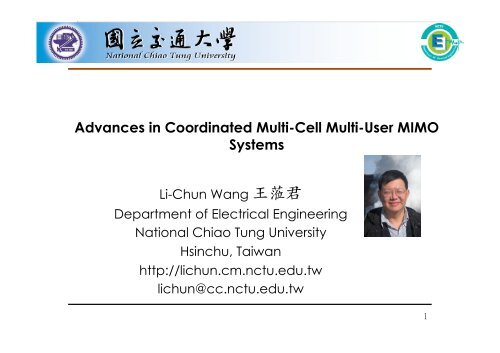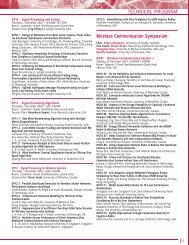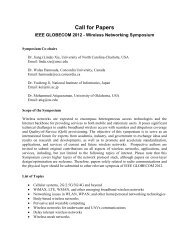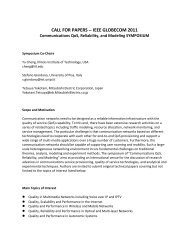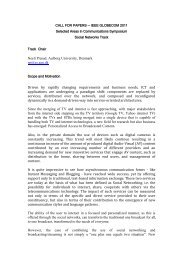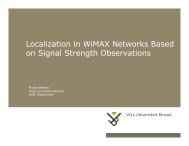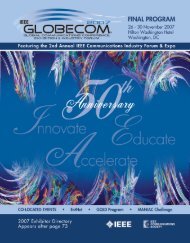Advances in Coordinated Multi-Cell Multi-User MIMO Systems
Advances in Coordinated Multi-Cell Multi-User MIMO Systems
Advances in Coordinated Multi-Cell Multi-User MIMO Systems
You also want an ePaper? Increase the reach of your titles
YUMPU automatically turns print PDFs into web optimized ePapers that Google loves.
<strong>Advances</strong> <strong>in</strong> Coord<strong>in</strong>ated <strong>Multi</strong>-<strong>Cell</strong> <strong>Multi</strong>-<strong>User</strong> <strong>MIMO</strong><br />
<strong>Systems</strong><br />
Li-Chun Wang <br />
Department of Electrical Eng<strong>in</strong>eer<strong>in</strong>g<br />
National Chiao Tung University<br />
Hs<strong>in</strong>chu, Taiwan<br />
http://lichun.cm.nctu.edu.tw<br />
lichun@cc.nctu.edu.tw
Information for presentation slides<br />
• http://www.ieee-globecom.org/2011/private
Outl<strong>in</strong>e<br />
1 Introduction to <strong>MIMO</strong> Antenna<br />
Techniques<br />
2 S<strong>in</strong>gle-cell <strong>Multi</strong>-user <strong>MIMO</strong> <strong>Systems</strong><br />
3 S<strong>in</strong>gle-cell <strong>Multi</strong>-user <strong>MIMO</strong> Broadcast<br />
<strong>Systems</strong><br />
4 <strong>Multi</strong>-cell Network <strong>MIMO</strong> systems<br />
5 Updates of Network <strong>MIMO</strong> Techniques <strong>in</strong><br />
3GPP LTE-A Updates<br />
6 Conclusions
Ma<strong>in</strong> Story<br />
• Story 1: Schedul<strong>in</strong>g <strong>in</strong> diversity-based <strong>MIMO</strong><br />
• Story 2: Schedul<strong>in</strong>g for multiplex<strong>in</strong>g-based <strong>MIMO</strong><br />
• Story 3: A robust multi-user <strong>MIMO</strong> broadcast<br />
system aga<strong>in</strong>st huge feedback channel<br />
variations<br />
• Story 4: Channel assignment for multi-cell<br />
Network <strong>MIMO</strong><br />
• Story 5: Viewpo<strong>in</strong>ts of 3GPP on network <strong>MIMO</strong>
What happened <strong>in</strong> 1895?
1895 <strong>in</strong> Taiwan
1895 <strong>in</strong> Italy<br />
It is dangerous to put limits on wireless! (1932)
Guglielmo Marconi (1874 ~ 1937)<br />
• In 1895 he began laboratory experiments and<br />
succeeded <strong>in</strong> send<strong>in</strong>g wireless signals over a<br />
distance of one and a half miles.<br />
• In 1896, he was granted the world's first patent for a<br />
system of wireless telegraphy.<br />
• On 12 December 1901, us<strong>in</strong>g a 150 meter (500ft) kitesupported<br />
antenna for reception, the message fwas<br />
received at Signal Hill <strong>in</strong> Newfoundland of Canada by the<br />
company's new high-power station at Poldhu, which was<br />
transmitted about 3,500 kilometres (2,200 mi).<br />
• Guglielmo Marconi and Ferd<strong>in</strong>and Braun won the<br />
Nobel Prize <strong>in</strong> Physics 1909.
Wireless 101<br />
The more th<strong>in</strong>gs changes, the more rema<strong>in</strong> the same.<br />
(Alphonse Karr, 1808)
What is the fundamental issue for wireless<br />
communications?<br />
Spectrum Efficiency
Some Milestones <strong>in</strong> Telecommunications<br />
• Fundamental resources (degrees of freedom) <strong>in</strong><br />
communication system eng<strong>in</strong>eer<strong>in</strong>g<br />
– Power (pre-1948),<br />
– Bandwidth (1948, Shannon Capacity)<br />
– complexity (1980, TCM),<br />
– Space (1998, Space-Times Process<strong>in</strong>g )<br />
11
An Open Issue<br />
What is the next possible degree of freedom<br />
that can be exploited for communications<br />
systems?<br />
12
Research Trends <strong>in</strong> Wireless Networks<br />
• The Past Two Decades: Key Developments at the L<strong>in</strong>k<br />
Level : <br />
– <strong>MIMO</strong>; MUD; Turbo<br />
• Today: An Increased Focus on Interactions Among Nodes<br />
– Competition <br />
» Cognitive radio <br />
» Information theoretic security <br />
» Game theoretic model<strong>in</strong>g, analysis & design<br />
– Collaboration <br />
» Network cod<strong>in</strong>g <br />
» Cooperative transmission & relay<strong>in</strong>g <br />
» <strong>Multi</strong>-hop transmission & coalition games <br />
» Collaborative beam-form<strong>in</strong>g <br />
» Collaborative <strong>in</strong>ference <br />
– Competition & Collaboration <strong>in</strong> Wireless Networks
H<strong>in</strong>t from this Talk<br />
How can we effectively exploit the degree of<br />
freedom <strong>in</strong> the user doma<strong>in</strong> to design multiuser<br />
<strong>MIMO</strong> and multi-cell network <strong>MIMO</strong><br />
systems?<br />
14
1. Introduction to <strong>MIMO</strong> Antenna<br />
Techniques<br />
(Story 1: Schedul<strong>in</strong>g <strong>in</strong> diversity-based<br />
<strong>MIMO</strong>)
<strong>Multi</strong>-Input <strong>Multi</strong>-Output (<strong>MIMO</strong>)<br />
Antenna Techniques<br />
• Independent parallel transmit and receive antenna<br />
pair<br />
• <strong>MIMO</strong> antenna techniques<br />
– boost channel capacity<br />
– enhance l<strong>in</strong>k reliability<br />
– reject strong <strong>in</strong>terference<br />
N t<br />
N r<br />
Tx<br />
…<br />
…<br />
Rx<br />
16
Diversity-<strong>Multi</strong>plex<strong>in</strong>g Tradeoff<br />
• Diversity -> improve l<strong>in</strong>k reliability by replicas<br />
a<br />
Tx<br />
a<br />
a<br />
a<br />
a<br />
Rx<br />
a<br />
• Multuplex<strong>in</strong>g -> enhance data rate by multiplex<strong>in</strong>g<br />
ba<br />
Tx<br />
a<br />
b<br />
a+b<br />
b+a<br />
Rx<br />
ba<br />
subchannel <strong>in</strong>terference<br />
cancel<strong>in</strong>g is required<br />
17
Schedul<strong>in</strong>g Techniques<br />
• Through periodically select<strong>in</strong>g the best user to serve, the<br />
system performance is improved by exploit<strong>in</strong>g multiuser<br />
diversity or cooperative diversity.<br />
• Ordered Statistics is the fundamental mathematical<br />
techniques for analyz<strong>in</strong>g the schedul<strong>in</strong>g wireless systems.<br />
user 1<br />
user 1<br />
user 2<br />
user 3<br />
1 2 3 4 5 6 7 8 9<br />
1 2 3 4 5 6 7 8 9<br />
18
A <strong>Multi</strong>user <strong>MIMO</strong> Schedul<strong>in</strong>g System<br />
• Perfect SNR estimation and noiseless feedback<br />
• H k =[ h ij<br />
(k)<br />
], each h ij<br />
(k)<br />
is subject to Nakagami fad<strong>in</strong>g<br />
• The BS selects the target user with highest effective<br />
SNR<br />
19
The Benefit from <strong>Multi</strong>user Schedul<strong>in</strong>g<br />
multiuser diversity or cooperative diversity
Nakagami-m Fad<strong>in</strong>g Channel <br />
Which one delivers the highest capacity ?
Impact of Channel Fad<strong>in</strong>g on System Capacity<br />
m=1<br />
m=1<br />
Two totally different stories for K=1 and K >1
A <strong>Multi</strong>user <strong>MIMO</strong> Schedul<strong>in</strong>g System<br />
• Perfect SNR estimation and noiseless feedback<br />
• H k =[ h ij<br />
(k)<br />
], each h ij<br />
(k)<br />
is subject to Nakagami fad<strong>in</strong>g<br />
• The BS selects the target user with highest effective SNR
A Generic Diversity-Based <strong>MIMO</strong> System<br />
The maximum diversity ga<strong>in</strong> = N t N r
Some Diversity-Based <strong>MIMO</strong> Schemes<br />
• Four exist<strong>in</strong>g diversity-based <strong>MIMO</strong> schemes are<br />
considered<br />
– ST/SC<br />
– ST/MRC<br />
– MRT/MRC<br />
– STBC<br />
ST : selective transmission<br />
SC : selective comb<strong>in</strong><strong>in</strong>g<br />
MRT : maximum ratio transmission<br />
MRC : maximum ratio comb<strong>in</strong><strong>in</strong>g<br />
STBC : space time block code<br />
• All of them can deliver full antenna diversity ga<strong>in</strong>
When Diversity-Based <strong>MIMO</strong> Meets<br />
<strong>Multi</strong>user Schedul<strong>in</strong>g<br />
• In general, schedul<strong>in</strong>g is a MAC layer technique to<br />
deliver multiuser diversity ga<strong>in</strong> by exploit<strong>in</strong>g<br />
<strong>in</strong>dependent channel fluctuations among users<br />
• By contrast, antenna diversity is a physical layer<br />
approach to offer reliable transmissions with the<br />
major goal of mitigat<strong>in</strong>g channel fad<strong>in</strong>g<br />
Induced l<strong>in</strong>k variation by<br />
diversity-based <strong>MIMO</strong><br />
SISO
A Closer Look for their Interplay<br />
Diversity-based<br />
<strong>MIMO</strong> L<strong>in</strong>k<br />
“peak”<br />
AF<br />
Array ga<strong>in</strong><br />
AF<br />
SISO
An Analytical Upper Bound<br />
• In [Chen & Wang ’04], we show that<br />
system capacity<br />
selection order<br />
AF ga<strong>in</strong><br />
array ga<strong>in</strong><br />
SNR<br />
Nakagami fad<strong>in</strong>g parameter
ST/SC over <strong>Multi</strong>user Schedul<strong>in</strong>g System<br />
SISO<br />
ST/SC<br />
MS 1<br />
MS 1<br />
virtual users<br />
MS 4<br />
virtual antennas<br />
MS 2<br />
MS 2<br />
MS 5<br />
Tx<br />
Rx-<br />
SC<br />
MS 3<br />
K=3, N t =1, N r =2<br />
MS 3<br />
MS6<br />
K=6, N t =1, N r =1<br />
K=1, N t =1, N r =6
MRT/MRC over <strong>Multi</strong>user Schedul<strong>in</strong>g System<br />
SISO<br />
SC<br />
MRC<br />
MRC<br />
SISO
STBC over <strong>Multi</strong>user Schedul<strong>in</strong>g System<br />
STBC (N t ,1)<br />
SISO<br />
STBC<br />
channel damp<strong>in</strong>g<br />
Fad<strong>in</strong>g<br />
channel<br />
m<br />
MS 1<br />
MS 2<br />
=<br />
Fad<strong>in</strong>g<br />
channel<br />
4*m<br />
MS 1<br />
MS 2<br />
<<br />
Fad<strong>in</strong>g<br />
channel<br />
m<br />
MS 1<br />
MS 2
System Capacity with Jo<strong>in</strong>t Antenna<br />
and <strong>Multi</strong>user Diversity
Ma<strong>in</strong> Po<strong>in</strong>t <strong>in</strong> Story 1<br />
• <strong>Multi</strong>user schedul<strong>in</strong>g and the diversity-based <strong>MIMO</strong><br />
with the multiuser schedul<strong>in</strong>g system may not be a<br />
good marriage.<br />
• Why?<br />
– <strong>User</strong> population, i.e. K, has contributed a large<br />
amount of diversity <strong>in</strong> the whole system<br />
– More important is their <strong>in</strong>tr<strong>in</strong>sic conflicts – one<br />
prefers variation, while the other creates<br />
tranquility
2. S<strong>in</strong>gle-cell <strong>Multi</strong>-user <strong>MIMO</strong><br />
<strong>Systems</strong><br />
(Story 2: Schedul<strong>in</strong>g for multiplex<strong>in</strong>g-based<br />
<strong>MIMO</strong>)
Issue for a Spatial <strong>Multi</strong>plex<strong>in</strong>g-based <strong>MIMO</strong><br />
• Diversity-multiplex<strong>in</strong>g tradeoff <strong>in</strong> a po<strong>in</strong>t-to-po<strong>in</strong>t <strong>MIMO</strong> system<br />
– multiplex<strong>in</strong>g ga<strong>in</strong> comes at the price of diversity ga<strong>in</strong> [Zheng &<br />
Tse ’03]<br />
– may translate <strong>in</strong>to smaller coverage areas if the SM <strong>MIMO</strong><br />
scheme is used [Catreux & Greenste<strong>in</strong> ‘03]<br />
MS<br />
• The coverage is def<strong>in</strong>ed as the maximum distance at which<br />
the l<strong>in</strong>k suffices for ma<strong>in</strong>ta<strong>in</strong><strong>in</strong>g a required receive SNR γ th with<br />
a probability, say 90%, at least<br />
35
Schedul<strong>in</strong>g Techniques<br />
• Through periodically select<strong>in</strong>g the best user to serve, the<br />
system performance is improved by exploit<strong>in</strong>g multiuser<br />
diversity or cooperative diversity.<br />
• Ordered Statistics is the fundamental mathematical<br />
techniques for analyz<strong>in</strong>g the schedul<strong>in</strong>g wireless systems.<br />
user 1<br />
user 1<br />
user 2<br />
user 3<br />
1 2 3 4 5 6 7 8 9<br />
1 2 3 4 5 6 7 8 9<br />
36
A <strong>Multi</strong>user <strong>MIMO</strong> Schedul<strong>in</strong>g System<br />
• Perfect SNR estimation and noiseless feedback<br />
• H k =[ h ij<br />
(k)<br />
], each h ij<br />
(k)<br />
is subject to Nakagami fad<strong>in</strong>g<br />
• The BS selects the target user with highest effective<br />
SNR<br />
37
The SWNSF Schedul<strong>in</strong>g Game<br />
SWNSF: strongest-weakestnormalized-subchannel-first<br />
<br />
MS 1<br />
MS 2<br />
MS 3<br />
38
Effect of SWNSF Schedul<strong>in</strong>g on m<strong>in</strong><br />
SWNSF schedul<strong>in</strong>g enhances the output SNR of the weakest subchannel<br />
λ 3 > λ 2 >λ 1
s<br />
u<br />
i<br />
d<br />
a<br />
r<br />
Effect of SWNSF Schedul<strong>in</strong>g on Coverage<br />
e<br />
g<br />
a<br />
r<br />
e<br />
v<br />
o<br />
c<br />
d<br />
e<br />
z<br />
i<br />
l<br />
a<br />
m<br />
r<br />
o<br />
N<br />
1.8<br />
1.6<br />
1.4<br />
1.2<br />
1<br />
0.8<br />
0.6<br />
N=2<br />
N=3<br />
MS<br />
<strong>MIMO</strong> + RR Schedul<strong>in</strong>g<br />
MS<br />
<strong>MIMO</strong> + SWNSF Schedul<strong>in</strong>g<br />
(“soft” coverage depends on K)<br />
0.4<br />
1 5 10 15 20 25 30<br />
Number of users K<br />
40
Effect of SWNSF Schedul<strong>in</strong>g on Other i
Coverage Extension & Capacity Improvement<br />
number of users<br />
number of antennas<br />
43
Ma<strong>in</strong> Po<strong>in</strong>t <strong>in</strong> Story 2<br />
<strong>Multi</strong>-<strong>User</strong> Schedul<strong>in</strong>g is<br />
A Soft Coverage Extension Technique<br />
"Enhanc<strong>in</strong>g Coverage and Capacity for <strong>Multi</strong>user <strong>MIMO</strong> <strong>Systems</strong> by Utiliz<strong>in</strong>g Schedul<strong>in</strong>g, "<br />
IEEE Trans. on Wireless Communications, Vol. 5, No. 5, pp. 1148-1157, May, 2006.
3. S<strong>in</strong>gle-cell <strong>Multi</strong>-user <strong>MIMO</strong><br />
Broadcast <strong>Systems</strong><br />
Story 3: A robust multi-user <strong>MIMO</strong> broadcast system<br />
aga<strong>in</strong>st huge feedback channel variations
<strong>MIMO</strong> Broadcast <strong>Systems</strong><br />
• <strong>MIMO</strong> antenna <strong>in</strong> po<strong>in</strong>t-to-po<strong>in</strong>t scenario can boost<br />
capacity through spatial multiplex<strong>in</strong>g.<br />
• <strong>MIMO</strong> broadcast systems (po<strong>in</strong>t-to-multiple) can transmit<br />
personalized data services to multiple users concurrently.<br />
Traditional po<strong>in</strong>t-to-po<strong>in</strong>t transmission<br />
Po<strong>in</strong>t-to-multiple transmissions <strong>in</strong> spatial doma<strong>in</strong>:<br />
<strong>Multi</strong>-<strong>User</strong> <strong>MIMO</strong> broadcast systems
Challenges <strong>in</strong> Transmit Beamform<strong>in</strong>g MU-<strong>MIMO</strong> <br />
• Types of MU-<strong>MIMO</strong> Transmit beamform<strong>in</strong>g systems:<br />
– Zero-forc<strong>in</strong>g (ZF) based transmit beamform<strong>in</strong>g<br />
– Block diagonalization (BD) based transmit<br />
beamform<strong>in</strong>g<br />
– Dirty paper cod<strong>in</strong>g (DPC)<br />
• Challenges of feedback channel design <strong>in</strong> transmit<br />
beamform<strong>in</strong>g MU-<strong>MIMO</strong> broadcast<br />
» Accuracy<br />
» Bandwidth => codebook solution
<strong>MIMO</strong> Broadcast <strong>Systems</strong> with<br />
Transmit Beamform<strong>in</strong>g<br />
H 1<br />
Receive<br />
Beamform<strong>in</strong>g<br />
Transmit<br />
Beamform<strong>in</strong>g<br />
W<br />
H K<br />
Receive<br />
Beamform<strong>in</strong>g<br />
H k<br />
M T M R complex-valued entries of channel matrix per user<br />
• Utilize feedback <strong>in</strong>formation to calculate the beamform<strong>in</strong>g weight W<br />
for <strong>in</strong>terference cancellation<br />
• ZF-DPC: QR-decomposition based transmit beamform<strong>in</strong>g<br />
• ZF: channel <strong>in</strong>verse based transmit beamform<strong>in</strong>g
<strong>MIMO</strong> Broadcast <strong>Systems</strong> with<br />
Jo<strong>in</strong>t Transmit Precod<strong>in</strong>g and Receive Equalizer<br />
Transmit<br />
Precod<strong>in</strong>g<br />
T k<br />
H 1<br />
Receive<br />
Equalizer<br />
Receive<br />
Equalizer<br />
H K<br />
R 1<br />
H k<br />
R K<br />
R k<br />
M T M R complex-valued entries of channel matrix per user<br />
Need return R k to each user!!<br />
• Utilize feedback <strong>in</strong>formation to calculate T k and R k for <strong>in</strong>terference<br />
cancellation – Block diagonalization (BD)
A Nonconformist (Why Not) Issue<br />
• Most MU-<strong>MIMO</strong> systems design transmit beamform<strong>in</strong>g<br />
(precod<strong>in</strong>g) at the transmitter side to cancel the <strong>in</strong>ter-stream<br />
<strong>in</strong>terference among serv<strong>in</strong>g users, but suffer from feedback<br />
channel errors and bandwidth issues.<br />
• Q. Can we have a different architecture to realize MU-<br />
<strong>MIMO</strong> broadcast systems?
Our Answer<br />
• Receive ZF beamform<strong>in</strong>g <strong>MIMO</strong> broadcast systems comb<strong>in</strong>ed<br />
with multiuser schedul<strong>in</strong>g<br />
• An alternative MU-<strong>MIMO</strong> technique to use feedback<br />
channel for a different purpose => user selection.<br />
• Has advantages <strong>in</strong> terms of robustness aga<strong>in</strong>st CSI<br />
and feedback l<strong>in</strong>k errors [Wang’10]<br />
[Wang’10] Li-Chun Wang and Chu-Jung Yeh, "Schedul<strong>in</strong>g for multiuser <strong>MIMO</strong><br />
broadcast systems: transmit or receive beamform<strong>in</strong>g?" IEEE Transactions on<br />
Wireless Communications, vol. 9, no. 9, pp. 2779 – 2791, Sep, 2010.
New Perspective: <strong>MIMO</strong> Broadcast <strong>Systems</strong> with<br />
Receive Beamform<strong>in</strong>g<br />
H 1<br />
Receive<br />
Beamform<strong>in</strong>g<br />
Transmit<br />
Beamform<strong>in</strong>g<br />
W 1<br />
[γ 1 , γ 2 , … ]<br />
M T SNR values<br />
H K<br />
Receive<br />
Beamform<strong>in</strong>g<br />
W K<br />
M T real-valued scalars per user (vector feedback)<br />
• Utilize feedback <strong>in</strong>formation to select the appropriate users<br />
• The receive ZF <strong>MIMO</strong> broadcast systems: channel <strong>in</strong>verse based<br />
receive beamform<strong>in</strong>g
Example of Receive ZF Beamform<strong>in</strong>g (3 x 3)<br />
• Feedback <strong>in</strong>formation<br />
– <strong>User</strong> 1: [1.25, 0.49, 0.50]<br />
– <strong>User</strong> 2: [0.81, 0.70, 2.25]<br />
– <strong>User</strong> 3: [0.49, 1.69, 1.21]<br />
Select<br />
Antenna 1 Antenna 2 Antenna 3<br />
<strong>User</strong> 1 <strong>User</strong> 3 <strong>User</strong> 2<br />
(Vector feedback)
Literature Survey on MU-<strong>MIMO</strong><br />
Tx BD Rx Note<br />
BD: Block diagonalization<br />
[Caire’03] o x x Concept of ZF-DPC and ZF beamform<strong>in</strong>g<br />
[J<strong>in</strong>dal’05] [Sharif’07] o x x The ga<strong>in</strong> of broadcast system over po<strong>in</strong>t-to-po<strong>in</strong>t<br />
transmission<br />
[Vishwanath’03]<br />
[Viswanath’03]<br />
[We<strong>in</strong>garten‘06]<br />
[Tu’03][Dimi´c’05]<br />
[Yoo’06][Bayesteh’08]<br />
[J<strong>in</strong>dal’06][Yoo’07]<br />
[Swannack‘06]<br />
[Caire’10] [D<strong>in</strong>g’07]<br />
[Zhang’09]<br />
[Spencer’04][Chen’08]<br />
[Shen’06,07]<br />
[Heath’01][Airy’04]<br />
[Chen’07]<br />
Our work <strong>in</strong> [Wang’10]<br />
[Wang’11a]<br />
[Wang’11b]<br />
o x x Theoretical capacity region of <strong>MIMO</strong> broadcast<br />
systems<br />
o x x Schedul<strong>in</strong>g algorithms and sum-rate performance<br />
evaluation and analysis<br />
o x x Under limited feedback condition: sum-rate analysis,<br />
codebook and schedul<strong>in</strong>g algorithm design<br />
x o x The concept, theoretical capacity, schedul<strong>in</strong>g<br />
algorithms of BD<br />
x x o Concept. scal<strong>in</strong>g law. sum-rate analysis under equal<br />
power allocation (M R = M T case)<br />
o o <br />
Effects of feedback channel variations (Part I)<br />
L<strong>in</strong>k performance analysis (Part 2)<br />
<br />
Effects of channel estimation error for receive ZF<br />
beamform<strong>in</strong>g (Part 3)
Key Analytic Results (M R = M T = M)<br />
• The sum rate of the receive ZF <strong>MIMO</strong> broadcast<br />
systems with water-fill<strong>in</strong>g power allocation<br />
The water-level solution of the equation<br />
– Utilize order statistics technique and long-term<br />
power constra<strong>in</strong>t for water-fill<strong>in</strong>g equation to derive<br />
the closed form<br />
Γ R (a,x): upper <strong>in</strong>complete gamma function<br />
E i (x): exponential <strong>in</strong>teger function of order i
Example of an MU-<strong>MIMO</strong> System with Receive ZF<br />
Beamform<strong>in</strong>g (3 x 3)<br />
• Feedback <strong>in</strong>formation<br />
– <strong>User</strong> 1: [1.25, 0.49, 0.50]<br />
– <strong>User</strong> 2: [0.81, 0.70, 2.25]<br />
– <strong>User</strong> 3: [0.49, 1.69, 1.21]<br />
Select<br />
Antenna 1 Antenna 2 Antenna 3<br />
<strong>User</strong> 1 <strong>User</strong> 3 <strong>User</strong> 2<br />
(Vector feedback)
Key Analytic Results (M R ¸ M T )<br />
• A general form of the sum rate with water-fill<strong>in</strong>g<br />
power allocation<br />
L = M R – M T<br />
Key steps <strong>in</strong> the closed form<br />
• Order statistics technique<br />
• Long-term power constra<strong>in</strong>t for water-fill<strong>in</strong>g<br />
equation<br />
• The <strong>in</strong>tegral identity provided <strong>in</strong> [Alou<strong>in</strong>i’99]<br />
The water-level solution of the equation
Sum Rate Comparison<br />
• Under similar feedback requirement<br />
M T values for feedback!!<br />
Transmit beamform<strong>in</strong>g: M T = {2, 4}; M R =1<br />
Receive beamform<strong>in</strong>g: M T = {2, 4} = M R<br />
RZFSTZFS <strong>in</strong> sum rate
What happen if feedback <strong>in</strong>formation is perturbed<br />
or channel estimation is <strong>in</strong>accurate?
Two Issues on channel <strong>in</strong>formation accuracy<br />
• Can receive beamform<strong>in</strong>g ZF <strong>MIMO</strong> broadcast systems<br />
tolerate feedback channel variations?<br />
• Can receive beamform<strong>in</strong>g ZF <strong>MIMO</strong> broadcast systems<br />
channel estimation errors?<br />
H 1<br />
Receive<br />
Beamform<strong>in</strong>g<br />
Transmit<br />
Beamform<strong>in</strong>g<br />
channel estimation errors<br />
[γ 1 , γ 2 , … ]<br />
H K<br />
Receive<br />
Beamform<strong>in</strong>g<br />
[Wang’07] each entry of<br />
E k is distributed by<br />
feedback channel variations (Part I-1)
Feedback CSI Variations<br />
• Adopt coefficient of variation (CV) to evaluate the impact<br />
of feedback CSI variations<br />
– Perturbed from the noisy estimated <strong>in</strong>formation, the<br />
outdated <strong>in</strong>formation, and quantization errors, etc.<br />
– For random variable X, CV = σ x / E[X]<br />
• For the feedback CSI x, the perturbed feedback CSI<br />
received at BS is<br />
x’ = x + <br />
– ~ N(0, σ x2 ) and σ x = CVx
Effects of Feedback CSI Variations<br />
on Sum Rate (CV = 0.5)<br />
K = 20, M T = M R = 3<br />
• With perfect CSI feedback<br />
– transmit beamform<strong>in</strong>g is better<br />
than receive beamform<strong>in</strong>g<br />
(1 ~ 1.5 nats/s/Hz)<br />
– ZF-DPC is the best one<br />
• With perturbed CSI feedback<br />
– Large sum rate degradation<br />
for transmit beamform<strong>in</strong>g<br />
(Reduce 19.7% ~ 33.8%)<br />
– Slight sum rate degradation for<br />
receive ZF beamform<strong>in</strong>g<br />
(Reduce 3.5%)
Effects of Feedback CSI Variations<br />
on Sum Rate (CV = 1.5)<br />
K = 20, M T = M R = 3<br />
• Receive ZF beamform<strong>in</strong>g is<br />
more robust to feedback CSI<br />
variations<br />
– 7% sum rate reduction<br />
– Keep the sum rate slope<br />
• Transmit beamform<strong>in</strong>g is more<br />
sensitive to feedback CSI<br />
variations<br />
– 38.8 ~ 61.1% sum rate<br />
reduction<br />
– Interference dom<strong>in</strong>ated sum<br />
rate performance
Summary<br />
• The MU-<strong>MIMO</strong> with receive beamform<strong>in</strong>g comb<strong>in</strong>ed with<br />
multiuser is still an <strong>in</strong>terest<strong>in</strong>g alternative MU-<strong>MIMO</strong> subject to<br />
feedback channel errors.<br />
• Imperfect CST at the receiver (CRI-R) will cause serious sum-rate<br />
performance degradation and cause the sum-rate floor.<br />
– Sum rate capacity will no longer l<strong>in</strong>early <strong>in</strong>crease with<br />
SNR <strong>in</strong> decibel and be bounded.
Ma<strong>in</strong> Po<strong>in</strong>t <strong>in</strong> Story 3<br />
<strong>Multi</strong>-user broadcast <strong>MIMO</strong> systems DO NOT<br />
require transmit beamform<strong>in</strong>g precoders.<br />
“Schedul<strong>in</strong>g for <strong>Multi</strong>user <strong>MIMO</strong> Broadcast <strong>Systems</strong>: Transmit or Receive<br />
Beamform<strong>in</strong>g?” IEEE Trans. on Wireless Communications, Vol. 9, No. 9.<br />
pp. 2779~2791, Sep. 2010.
4. <strong>Multi</strong>-cell Network <strong>MIMO</strong><br />
systems<br />
Story 4: Channel assignment for multi-cell<br />
Network <strong>MIMO</strong>
What and Why Network <strong>MIMO</strong>?<br />
• Inter-cell <strong>in</strong>terference: In conventional cellular systems, the<br />
solution is us<strong>in</strong>g larger frequency reuse among cells<br />
– Poorer spectral efficiency!!<br />
Inter-stream <strong>in</strong>terference free!!<br />
<strong>MIMO</strong> broadcast system<br />
CSI exchange through high-speed backbaul<br />
Inter-cell <strong>in</strong>terference free!!<br />
Network <strong>MIMO</strong> system<br />
The concept is also used <strong>in</strong> 3GPP LTE-A (CoMP) and IEEE 802.16m (Co-<strong>MIMO</strong>)
key Issues for Network <strong>MIMO</strong><br />
2nd-tier neighbor<strong>in</strong>g cells<br />
1st-tier neighbor<strong>in</strong>g cells<br />
Conventional omni-cell approach<br />
IGI causes serious signal<br />
quality degradation<br />
14 dB degradation for 7-cell network <strong>MIMO</strong><br />
23 dB degradation for 3-cell network <strong>MIMO</strong>
Literature Survey<br />
FFR?<br />
Sector or<br />
omni-cell?<br />
Network<br />
<strong>MIMO</strong>?<br />
Note<br />
[Lei’07],<br />
[Fujii’08]<br />
[Chiu’08]<br />
[Shamai’01]<br />
[Karakayali’06]<br />
o sector x SINR improvement and soft<br />
handoff scheme<br />
x omni o The concept of multi-base<br />
station cooperation<br />
[Somekh’06]<br />
[J<strong>in</strong>g’07]<br />
x<br />
Wyner’s<br />
model<br />
o<br />
Performance analysis based<br />
on Wyner’s circular cell model<br />
[Zhang’09] x omni o BD-based network <strong>MIMO</strong><br />
performance<br />
[Boccardi’07]<br />
[Huang’09]<br />
x sector o Effect of network <strong>MIMO</strong><br />
+ 3, 6, 12 sector per cell<br />
Our work o sector o Design a 3-cell network <strong>MIMO</strong><br />
<strong>in</strong> FFR tri-sector cell
Basic Fractional Frequency Reuse (FFR) Concept
FFR <strong>in</strong> Tri-Sector <strong>Cell</strong>*<br />
(Regular Approach) <br />
Each cell has the same frequency partition!!<br />
*F. Khan, LTE for 4G Mobile Broadband: Air Interface Technologies and Performance, 1st ed. Cambridge University Press, 2009.
Proposed Solution<br />
Coord<strong>in</strong>ated group under<br />
certa<strong>in</strong> frequency band<br />
FFR: fractional frequency reuse
Regular versus Rearranged Frequency Partitions<br />
A cell can simultaneously forms 3 groups with neighbor<strong>in</strong>g 6 cells
Benefit of Rearranged Frequency Partition<br />
• Extra 8.5 dB SINR improvement!!<br />
(compared to traditional tri-sector FFR)<br />
10 dB improvement for sector<strong>in</strong>g FFR<br />
Extra 2.7 dB ga<strong>in</strong> under regular<br />
partition + 3-cell network <strong>MIMO</strong><br />
Extra 8.5 dB ga<strong>in</strong> under rearranged<br />
partition + 3-cell network <strong>MIMO</strong><br />
90% percentile
Proposed Architecture with 60 o Sector<strong>in</strong>g
Benefit of Proposed Architecture<br />
over Conventional Approach<br />
• A smaller coord<strong>in</strong>ation, 3-cell network <strong>MIMO</strong> architecture, can<br />
even outperform conventional 7-cell network <strong>MIMO</strong> system<br />
– 2 dB SINR improvement for 60 o sector<strong>in</strong>g<br />
– 3 dB SINR improvement for 120 o sector<strong>in</strong>g<br />
Traditional 7-cell approach<br />
Proposed 3-cell approach<br />
with rearranged partition
Benefit of <strong>Multi</strong>ple Antennas at the Base Station<br />
• Each sector BS equips with t transmit antennas to serve t<br />
users simultaneously.<br />
• 3-cell network coord<strong>in</strong>ation with proposed rearranged trisector<br />
frequency partition.<br />
– Total 3t transmit antennas serve 3t user term<strong>in</strong>als<br />
Almost l<strong>in</strong>ear sum rate improvement<br />
as number of antennas t <strong>in</strong>creases<br />
Proposed network <strong>MIMO</strong> architecture<br />
achieves extra ga<strong>in</strong> over conventional<br />
approach
Summary<br />
• By exploit<strong>in</strong>g geographic cell distribution and frequency<br />
partition, a 3-cell network <strong>MIMO</strong> can outperform<br />
conventional 7-cell network <strong>MIMO</strong> with omni-directional cell<br />
• This k<strong>in</strong>d of 3-cell coord<strong>in</strong>ated network <strong>MIMO</strong> architectures<br />
is particularly useful<br />
– The default number of neighbor<strong>in</strong>g cells <strong>in</strong> the Co-<strong>MIMO</strong><br />
transmission is three for IEEE 802.16m<br />
– In LTE-A RAN 1 meet<strong>in</strong>g, the number of coord<strong>in</strong>ation <strong>in</strong><br />
CoMP is also three<br />
CoMP: coord<strong>in</strong>ated multi-po<strong>in</strong>t<br />
Co<strong>MIMO</strong>: collaborative multiple-<strong>in</strong>put multiple-output
Ma<strong>in</strong> Po<strong>in</strong>t <strong>in</strong> Story 4<br />
Network <strong>MIMO</strong> systems only need 3 cell site<br />
to cooperate<br />
• Li-Chun Wang and Chu-Jung Yeh, “3-<strong>Cell</strong> network <strong>MIMO</strong> architectures<br />
with sectorization and fractional frequency reuse,” IEEE Journal <strong>in</strong><br />
Selected Area <strong>in</strong> Communications, Vol. 29, No. 6, pp. 1185~1199,<br />
June, 2011<br />
• Li-Chun Wang and Chu-Jung Yeh, “Antenna architectures for network<br />
<strong>MIMO</strong>,” Cooperative <strong>Cell</strong>ular Wireless Networks,” Cambridge University<br />
Press, ISBN-13: 9780521767125.<br />
• IEEE C802.16m-09/2280 “Frequency Plann<strong>in</strong>g for Inter-<strong>Cell</strong><br />
Interference Reduction <strong>in</strong> 3-<strong>Cell</strong> Collaborative <strong>MIMO</strong> <strong>Systems</strong>”
5. Updates of Network <strong>MIMO</strong><br />
Techniques <strong>in</strong> 3GPP LTE-A<br />
Updates
3GPP LTE/HSPA Evolution <br />
HSPA Series Evolution<br />
(CDMA-based)<br />
• DL: 2x2 <strong>MIMO</strong><br />
• DL: 2x2 <strong>MIMO</strong>+64QAM<br />
or DC+64QAM<br />
• DL: DC+64QAM+<strong>MIMO</strong><br />
• UL: DC<br />
• DL: 4-Carrier<br />
LTE Series Evolution<br />
(OFDM-based)<br />
Note: Dates refer to the first completed (full) specifications<br />
81<br />
• DL: 4x4 <strong>MIMO</strong> <strong>in</strong> 20MHz<br />
3GPP Concept for<br />
IMT-A (4G)
LTE-A Key Technologies<br />
• Carrier Aggregation<br />
– Aggregate bandwidth up to 100MHz<br />
• Downl<strong>in</strong>k transmission scheme<br />
– Improvements to LTE by us<strong>in</strong>g 8x8 <strong>MIMO</strong><br />
– Data rates of 100Mb/s with high mobility and 1Gb/s<br />
with low mobility<br />
• Upl<strong>in</strong>k transmission scheme<br />
– Improvements to LTE by us<strong>in</strong>g 4x4 <strong>MIMO</strong><br />
– Data rates up to 500Mb/s<br />
• Relay Functionality<br />
– Improv<strong>in</strong>g cell edge coverage<br />
– More efficient coverage <strong>in</strong> rural areas<br />
82
Advanced <strong>MIMO</strong> Techniques <strong>in</strong> DL<br />
• Extension up to 8-stream transmission<br />
– Increased from 4 streams <strong>in</strong> Rel-8/9<br />
– Satisfy peak SE requirement (i.e., 30 bps/<br />
Hz)<br />
• Support for enhanced MU-<strong>MIMO</strong><br />
– Not more than 4 UEs are co-scheduled<br />
– Not more than 2 layers per UE<br />
83
Advanced <strong>MIMO</strong> Techniques <strong>in</strong> UL<br />
• Introduction of SU-<strong>MIMO</strong> up to 4-stream<br />
transmission<br />
– Rel. 8 LTE does not support SU-<strong>MIMO</strong><br />
– Satisfy peak SE requirement (i.e., 15 bps/<br />
Hz)<br />
• Introduction of UL transmit diversity for<br />
PUCCH<br />
– Improved signal<strong>in</strong>g robustness and celledge<br />
performance<br />
84
Enhanced ICIC<br />
• Enhanced ICIC for non-CA based deployments<br />
of heterogeneous networks for LTE<br />
– WI proposed by CMCC <strong>in</strong> RAN#47 (Mar. 2010)<br />
– Identify and evaluate non-CA based ICIC strategies<br />
of heterogeneous network deployments<br />
– HetNet use cases are priorities as follows:<br />
» Indoor HeNB clusters<br />
» Outdoor Hotzone cells<br />
» Indoor Hotzone scenarios<br />
85
R10 LTE-A Performance Improvement<br />
• Rel-8 LTE vs. IMT-A requirements<br />
– DL: Rel-8 LTE fulfills IMT-A requirements<br />
– UL: Need to double from Rel-8 to satisfy<br />
IMT-A requirement<br />
FDD Rel-8 LTE (1) Rel-10LTE-A (2) IMT-Advanced<br />
Peak spectrum efficiency<br />
[bps/Hz]<br />
DL 16.3 30.6 15<br />
UL 4.3 16.8 6.75<br />
TDD Rel-8 LTE (1) Rel-10LTE-A (2) IMT-Advanced<br />
Peak spectrum efficiency<br />
[bps/Hz]<br />
DL 16 30 15<br />
UL 4 16.1 6.75<br />
Note:<br />
(1)<br />
4x4 <strong>MIMO</strong> <strong>in</strong> DL, SIMO <strong>in</strong> UL<br />
(2)<br />
8x8 <strong>MIMO</strong> <strong>in</strong> DL, 4x4 <strong>MIMO</strong> <strong>in</strong> UL <br />
Source: 3GPP TR 36.912<br />
86
R11 LTE-A New Technical Issues<br />
• CoMP (Coord<strong>in</strong>ated <strong>Multi</strong>po<strong>in</strong>t Transmission and Reception)<br />
• MTC (Mach<strong>in</strong>e-Type Communications )<br />
• Network Energy Sav<strong>in</strong>g<br />
• MODAI (Mobile Data Impact)<br />
87
CoMP (Coord<strong>in</strong>ated <strong>Multi</strong>po<strong>in</strong>t Transmission and Reception)<br />
• New study Item <strong>in</strong> Rel-10<br />
– Approved <strong>in</strong> RAN#47 (Mar. 2010)<br />
• DL CoMP Transmission Scheems<br />
– Jo<strong>in</strong>t Process<strong>in</strong>g<br />
» Jo<strong>in</strong>t transmission/dynamic cell selection<br />
– Coord<strong>in</strong>ated Schedul<strong>in</strong>g/Beamform<strong>in</strong>g<br />
• Better cell edge performance<br />
– Less co-channel <strong>in</strong>terference / more signal<br />
88
Jo<strong>in</strong>t Process<strong>in</strong>g (JP)<br />
The coord<strong>in</strong>ated cells will serve the user together. The base<br />
station will exchange the channel state <strong>in</strong>formation (CSI)<br />
and data to each other.<br />
CSI and data exchange between each base station<br />
Coord<strong>in</strong>ated transmission to the<br />
user
Coord<strong>in</strong>ated Beamform<strong>in</strong>g (CB)<br />
If there are two users close to each other but <strong>in</strong> different cells.<br />
By sett<strong>in</strong>g the appropriate beam<strong>in</strong>g weight, we can decrease the<br />
<strong>in</strong>terference from different base stations. <br />
Only CSI exchange between each base station<br />
Only one base station will transmit to the user
Coord<strong>in</strong>ated Schedul<strong>in</strong>g (CS)<br />
Use the coord<strong>in</strong>ated schedul<strong>in</strong>g to decide which user will be<br />
serve. Even without <strong>in</strong>terference null<strong>in</strong>g, we can avoid the<br />
<strong>in</strong>terference from the other base stations.<br />
Only CSI exchange between each base station<br />
Only one base station will transmit to the appropriate user
Mulit-<strong>Cell</strong> Co-operations<br />
Jo<strong>in</strong>t Process<strong>in</strong>g<br />
for <strong>User</strong> Data<br />
Shared CSI <strong>in</strong><br />
<strong>Multi</strong>-Sites<br />
Jo<strong>in</strong>t<br />
DataTransmission<br />
Interference<br />
Null<strong>in</strong>g<br />
JP CB CS<br />
☺ X X<br />
☺ ☺ ☺<br />
group 1 1<br />
☺ ☺ X<br />
Beamform<strong>in</strong>g ☺ ☺ ☺<br />
JP : Jo<strong>in</strong>t Process<strong>in</strong>g<br />
CB : Coord<strong>in</strong>ated<br />
Beamform<strong>in</strong>g<br />
CS : Coord<strong>in</strong>ated Schedul<strong>in</strong>g
4 Scenarios for CoMP <strong>in</strong> 3GPP LTE-A <br />
• Accord<strong>in</strong>g to R1-110564 <strong>in</strong> 3GPP, CoMP (coord<strong>in</strong>ated<br />
multipo<strong>in</strong>t transmission) techniques are applied <strong>in</strong> the<br />
follow<strong>in</strong>g 4 scenario<br />
Scenario 1 : Homogeneous network with <strong>in</strong>tra-site<br />
Scenario 3 : Heterogeneous network with low power<br />
RRHs, which create cells with their own cell ID.<br />
Scenario 2 : Homogeneous network with high Tx power<br />
RRHs<br />
Scenario 4 : Heterogeneous network with low power<br />
RRHs, which create cells with the same cell ID as the macro.
NCTU has built a LTE-A System-Level Simulator<br />
• In order to propose new techniques for LTE-A systems, we must<br />
establish the LTE-A system-level simulator and calibrate the<br />
performance metrics <strong>in</strong> 3GPP TR36.814.<br />
Step(1a) : wideband<br />
SINR<br />
Path-loss, Shadow<strong>in</strong>g, Antenna Pattern<br />
Step(1c) : DL SINR and cell<br />
spectral efficiency<br />
Spatial Channel Model, OFDMA, MRC Antenna<br />
Comb<strong>in</strong><strong>in</strong>g, Adaptive MCS , HARQ<br />
SU/MU-<strong>MIMO</strong><br />
Codebook-based Precoder, MMSE receiver, Rank<br />
Adaptation, SU/MU Mode Switch<strong>in</strong>g<br />
Hierarchical Network<br />
<strong>MIMO</strong><br />
RRH Selection, Cooperation/Non-cooperation<br />
mode switch<strong>in</strong>g
<strong>MIMO</strong> Physical Layer Simulation Flow Chart
NCTU LTE-A System-Level Simulator Interface
Hierarchical Base Station Cooperation with<br />
S<strong>in</strong>gle <strong>Cell</strong> ID (HBSC-S)<br />
• If the RRH nodes share the same cell ID with the correspond<strong>in</strong>g<br />
macro-BS, the RRH nodes can be regarded as the distributed<br />
antennas of the macro-BS. We call the system as Hierarchical<br />
Base Station Cooperation with the S<strong>in</strong>gle cell ID (HBSC-S).
Hierarchical Base Station Cooperation with<br />
<strong>Multi</strong>ple <strong>Cell</strong> IDs (HBSC-M)<br />
• We apply the cooperation technique to mitigate the <strong>in</strong>tra-cell<br />
<strong>in</strong>terference.<br />
• We call the system as Hierarchical Base Station Cooperation with<br />
<strong>Multi</strong>ple cell IDs (HBSC-M).
Wideband SINR for Calibration Step 1a<br />
Our calibration result is consistent with those <strong>in</strong><br />
3GPP.
Spectral Efficiency for Calibration Step 1c<br />
Our calibration result is consistent with those <strong>in</strong><br />
3GPP.
Spectral Efficiency for <strong>MIMO</strong> <strong>Systems</strong><br />
• All our simulation results are consistent with those <strong>in</strong><br />
3GPP.<br />
Spectral<br />
Efficiency<br />
2x2 SU-<strong>MIMO</strong><br />
<strong>Cell</strong>-Average<br />
2x2 SU-<strong>MIMO</strong><br />
5% <strong>Cell</strong>-Edge<br />
4x2 SU-<strong>MIMO</strong><br />
<strong>Cell</strong> Average<br />
4x2 SU-<strong>MIMO</strong><br />
5% <strong>Cell</strong>-Edge<br />
2x2 MU-<strong>MIMO</strong><br />
<strong>Cell</strong>-Average<br />
2x2 MU-<strong>MIMO</strong><br />
5% <strong>Cell</strong>-Edge<br />
M<strong>in</strong>-value of<br />
others <strong>in</strong> 3GPP<br />
(bits/s/Hz)<br />
Our Work<br />
(bits/s/Hz)<br />
Max-value of<br />
others <strong>in</strong> 3GPP<br />
(bits/s/Hz)<br />
2.14 2.37 2.47<br />
0.072 0.079 0.100<br />
2.34 2.52 2.66<br />
0.085 0.089 0.110<br />
2.56 2.62 2.77<br />
0.070 0.086 0.110
Spectral Efficiency for HBSC-M <strong>Systems</strong> <strong>in</strong> <strong>Multi</strong>-<strong>Cell</strong><br />
Case<br />
• HBSC-M systems outperform both the HBSC-S systems and the SU-<br />
<strong>MIMO</strong> system <strong>in</strong> the spectral efficiency.<br />
• The best position for each RRH node is 0.6R~0.7R.<br />
+12%<br />
+ 20%
Energy Efficiency for HBSC <strong>Systems</strong><br />
• When consider<strong>in</strong>g the energy efficiency (bits/<br />
Joule), the HBSC-S system with 1 RRH selected<br />
outperforms the HBSC-M system.<br />
+ 9%
Ma<strong>in</strong> Po<strong>in</strong>t <strong>in</strong> Story 5<br />
LTE-A system-level simulator support<strong>in</strong>g<br />
hierarchical network <strong>MIMO</strong> is important.<br />
3GPP R1-111528, “Simulation Evaluation for CoMP Scenarios 3 and 4”,<br />
May 2011<br />
“Performance Calibration and Simulation Methodology for<br />
3GPP LTE-A <strong>Systems</strong>.” IEEE VTS APWCS, Aug. 2011<br />
2011/7
Conclusions<br />
• We have discussed multiuser <strong>MIMO</strong> communications<br />
systems from the perspective of radio resource arrangement<br />
and place emphasis on user schedul<strong>in</strong>g and channel<br />
assignment correctly.<br />
• Ma<strong>in</strong> po<strong>in</strong>t: If we utilize the degree of freedom <strong>in</strong> the user<br />
doma<strong>in</strong> cleverly, we can deliver many advantages to MU-<br />
<strong>MIMO</strong> and network <strong>MIMO</strong>:<br />
– enhanc<strong>in</strong>g coverage and capacity simultaneously;<br />
– Improv<strong>in</strong>g robustness to channel variations;<br />
– Reduc<strong>in</strong>g the necessity of large number of cooperative<br />
cell site.
Future Research Directions<br />
• Channel state feedback for downl<strong>in</strong>k network <strong>MIMO</strong><br />
• Asynchronous upl<strong>in</strong>k network <strong>MIMO</strong><br />
• Hierarchical network <strong>MIMO</strong>
F<strong>in</strong>al remark<br />
Com<strong>in</strong>g together is a beg<strong>in</strong>n<strong>in</strong>g.<br />
Keep<strong>in</strong>g together is progress.<br />
Work<strong>in</strong>g together is success.<br />
~ Henry Ford
References<br />
• C. J. Chen and Li-Chun Wang, "Enhanc<strong>in</strong>g Coverage and Capacity for<br />
<strong>Multi</strong>user <strong>MIMO</strong> <strong>Systems</strong> by Utiliz<strong>in</strong>g Schedul<strong>in</strong>g, ” IEEE Trans. on Wireless<br />
Communications, Vol. 5, No. 5, pp. 1148-1157, May, 2006.<br />
• C. J. Chen and Li-Chun Wang, “A Unified Capacity Analysis for Wireless<br />
<strong>Systems</strong> with Jo<strong>in</strong>t <strong>Multi</strong>user Schedul<strong>in</strong>g and Antenna Diversity <strong>in</strong><br />
Nakagami Fad<strong>in</strong>g Channels,” IEEE Trans. on Communications, vol. 54, No.<br />
3, pp. 469~478, Mar. 2006.<br />
• Li-Chun Wang and Chu-Jung Yeh, “Schedul<strong>in</strong>g for <strong>Multi</strong>user <strong>MIMO</strong><br />
Broadcast <strong>Systems</strong>: Transmit or Receive Beamform<strong>in</strong>g?” IEEE Trans. on<br />
Wireless Communications, Vol. 9, No. 9. pp. 2779~2791, Sep. 2010.<br />
• Li-Chun Wang and Chu-Jung Yeh, “3-<strong>Cell</strong> network <strong>MIMO</strong> architectures<br />
with sectorization and fractional frequency reuse,” IEEE Journal <strong>in</strong><br />
Selected Area <strong>in</strong> Communications, Vol. 29, No. 6, pp. 1185~1199, June,<br />
2011<br />
• Li-Chun Wang and Chu-Jung Yeh, “Antenna architectures for network<br />
<strong>MIMO</strong>,” Cooperative <strong>Cell</strong>ular Wireless Networks,” Cambridge University<br />
Press, ISBN-13: 9780521767125.<br />
• IEEE C802.16m-09/2280 “Frequency Plann<strong>in</strong>g for Inter-<strong>Cell</strong> Interference<br />
Reduction <strong>in</strong> 3-<strong>Cell</strong> Collaborative <strong>MIMO</strong> <strong>Systems</strong>”
References<br />
• Y. J. Liu, T. T. Chiang and Li-Chun Wang “Performance Calibration and<br />
Simulation Methodology for 3GPP LTE-A <strong>Systems</strong>.” IEEE VTS APWCS, Aug.<br />
2011<br />
• 3GPP R1-111528, “Simulation Evaluation for CoMP Scenarios 3 and 4”,May<br />
2011<br />
• -------------------------------------------------------------------------------------
Reference<br />
[1] TR 36.814 : 3rd Generation Partnership Project ; Technical Specification<br />
Group Radio Access Network; Evolved Universal Terrestrial Radio Access (E-<br />
UTRA); Further advancements for E-UTRA physical layer aspects (Release 9)<br />
[2] TR 36.819 : 3rd Generation Partnership Project;Technical Specification<br />
Group Radio Access Network; Coord<strong>in</strong>ated multi-po<strong>in</strong>t operation for LTE<br />
physical layer aspects(Release 11)<br />
[3] M.2135 Report ITU-R M.2135-1(12/2009) Guidel<strong>in</strong>es for evaluation of radio<br />
<strong>in</strong>terface technologies for IMT-Advanced M Series Mobile,<br />
radiodeterm<strong>in</strong>ation, amateur and related satellites services<br />
[4] S. Shamai and B. M. Zaidel, “Enhanc<strong>in</strong>g the cellular downl<strong>in</strong>k capacity via<br />
co-process<strong>in</strong>g at the transmitt<strong>in</strong>g end,” IEEE Vehicular Technology<br />
Conference Spr<strong>in</strong>g, vol. 3, pp. 1745 – 1749, May 2001.<br />
[5] H. Zhang and H. Dai, “Cochannel <strong>in</strong>terference mitigation and<br />
cooperative process<strong>in</strong>g <strong>in</strong> downl<strong>in</strong>k multicell multiuser <strong>MIMO</strong> networks,”<br />
EURASIP Journal on Wireless Communications and Network<strong>in</strong>g, vol. 2004, no.<br />
2, pp. 222–235, 2004.
Reference<br />
[6] G. J. Fosch<strong>in</strong>i, K. Karakayali, and R. A. Valenzuela, “Coord<strong>in</strong>at<strong>in</strong>g multiple<br />
antenna cellular networks to achieve enormous spectral efficiency,” IEE<br />
Proceed<strong>in</strong>gs-Communications, vol. 153, no. 4, pp. 548 – 555, Aug. 2006.<br />
[7] S. J<strong>in</strong>g, D. N. C. Tse, J. B. Soriaga, J. Hou, J. E. Smee, and R. Padovani,<br />
“<strong>Multi</strong>cell downl<strong>in</strong>k capacity with coord<strong>in</strong>ated process<strong>in</strong>g,” EURASIP<br />
Journal on Wireless Communications and Network<strong>in</strong>g, 2008.<br />
[8] H. Huang, M. Trivellato, A. Hott<strong>in</strong>en, M. Shafi, P. Smith, and R. Valenzuela,<br />
“Increas<strong>in</strong>g downl<strong>in</strong>k cellular throughput with limited network <strong>MIMO</strong><br />
coord<strong>in</strong>ation,” IEEE Transactions on Wireless Communications, vol. 8, no.<br />
6, Jun. 2009.<br />
[9] F. Richter, A. J. Fehske, and G. Fettweis, “Energy efficiency aspects of<br />
base station deployment strategies for cellular networks,” IEEE Vehicular<br />
Technology Conference Fall, Sep. 2009.<br />
[10] A. J. Fehske, P. Marsch, and G. P. Fettweis, “Bit per Joule efficiency of<br />
cooperat<strong>in</strong>g base stations <strong>in</strong> cellular networks,” IEEE GLOBECOM<br />
Workshops, Dec. 2010.
Reference<br />
[11] J. Salo, G. Del Galdo, J. Salmi, P. Kyosti, M. Milojevic, D. Laselva, and C.<br />
Schneider. (2005, Jan.) MATLAB implementation of the 3GPP Spatial<br />
Channel Model (3GPP TR 25.996). [Onl<strong>in</strong>e]. Available: http://www.tkk.fi/<br />
Units/Radio/scm<br />
[12] 3GPP, R1-110867, “CoMP with lower Tx power RRH <strong>in</strong> heterogeneous<br />
network,” NTT DOCOMO, Feb. 21-25, 2011.<br />
[13] L. Thiele, T. Wirth, M. Schellmann, Y. Hadisusanto, and V. Jungnickel, “MU-<br />
<strong>MIMO</strong> with localized downl<strong>in</strong>k base station cooperation and downtilted<br />
antennas,” IEEE International Conference on Communications<br />
Workshops, pp. 1–5, 2009.<br />
[14] N. J<strong>in</strong>dal, “Antenna comb<strong>in</strong><strong>in</strong>g for the <strong>MIMO</strong> downl<strong>in</strong>k channel,” IEEE<br />
Transactions on Wireless Communications, vol. 7, no. 10, pp. 3834–3844,<br />
Oct. 2008.<br />
[15] S. Fang, G. Wu, Y. Xiao, and S. Q. Li, “<strong>Multi</strong>-user <strong>MIMO</strong> l<strong>in</strong>ear precod<strong>in</strong>g<br />
with grassmannian codebook,” International Conference on<br />
Communications and Mobile Comput<strong>in</strong>g, vol. 1, pp. 250–255, 2009
Reference<br />
[16]. M. Sawahashi, Y. Kishiyama, A. Morimoto, D. Nishikawa, and M. Tanno,<br />
“Coord<strong>in</strong>ated multipo<strong>in</strong>t transmission/ reception techniques for LTE-<br />
Advanced,” IEEE Wireless Commun. Mag., pp. 26-34, June 2010.<br />
[17]. S. A. Jafar, “Interference Alignment: A New Look at Signal Dimensions <strong>in</strong><br />
a Communication Network,” Foundations and Trends <strong>in</strong> Communications<br />
and Information Theory, 2011.


